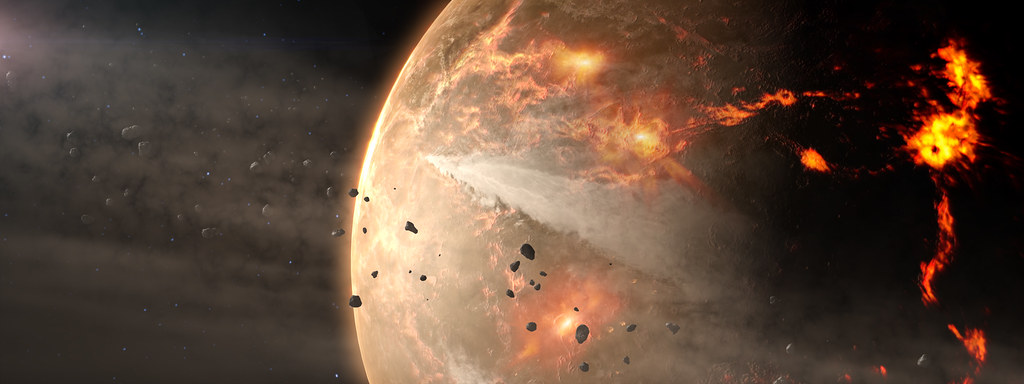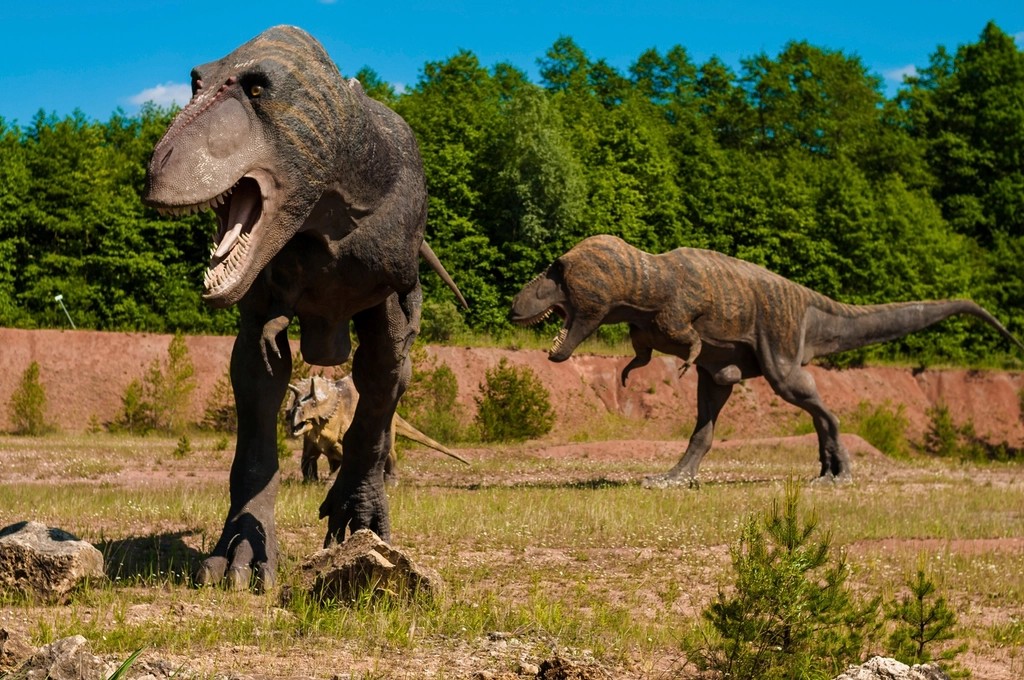You’ve probably gazed up at a meteor shower and felt that magical connection to the cosmos, those brilliant streaks painting temporary masterpieces across the night sky. Yet what you’re witnessing is just the tiniest glimpse of a cosmic relationship that fundamentally transformed our planet billions of years ago. During Earth’s ancient past, meteor bombardments didn’t just create pretty light shows. They literally rewrote the chemical rules of our atmosphere and set the stage for life as we know it today.
Picture Earth over four billion years ago, a world so alien it might as well have been on another planet entirely. The atmosphere was a toxic cocktail completely hostile to most life forms we recognize, yet this harsh environment was about to undergo a transformation that would echo through geological time.
When Earth Looked Like an Alien World

During the Archean eon, which lasted from 4 to 2.5 billion years ago, Earth’s atmosphere was completely different from what we breathe today. The atmosphere was a reducing environment rich in methane and completely lacking free oxygen, making it utterly inhospitable to the oxygen-breathing creatures that would eventually populate our world.
Surface oxygen levels were less than one millionth of present amounts, while nitrogen levels were similar to today or possibly several times lower. Meanwhile, carbon dioxide and methane levels ranged from roughly 10 to 2,500 times and 100 to 10,000 times modern amounts, respectively. This wasn’t the Earth we know. This was a greenhouse world where abundant methane, carbon dioxide, sulfur, and nitrogen compounds dominated the atmosphere.
The Cosmic Bombardment That Never Ended

Between about 4.1 and 3.8 billion years ago, Earth and the Moon experienced a second large spike of asteroid and comet impacts in an event called the Late Heavy Bombardment. However, the bombardment didn’t end there. Evidence from spherule layers suggests that impacts continued into the later Archean, at an average rate of about one impactor with a diameter greater than 10 kilometers every 15 million years.
Think about that for a moment. This is about the size of the Chicxulub impactor that wiped out the dinosaurs, and objects of this magnitude were hitting Earth roughly every 15 million years throughout much of the Archean. Recent models suggest early Earth endured an impact approximately every 15 million years, which is about 10 times more often than previous models estimated. That may seem infrequent, but geologically speaking, that’s an incredible bombardment rate.
The Chemistry of Destruction and Creation

When these massive space rocks slammed into Earth, they didn’t just create spectacular explosions. Each asteroid or comet collision created a giant vapor plume, with some of the vaporized rock condensing and solidifying as it fell back to Earth to form thin layers of sand-size particles known as impact spherules. These tiny glassy particles became markers of ancient catastrophes, scattered across the globe in distinct geological layers.
When large asteroids or comets struck early Earth, the energy released melted and vaporized rocky materials in the Earth’s crust, creating small droplets of molten rock that would condense, solidify, and fall back to Earth. The chemical reactions that followed were extraordinary. When the miniscule fireballs re-entered the atmosphere, they created massive amounts of nitrogen oxide gases, fundamentally altering the atmospheric chemistry.
How Meteors Became Oxygen Thieves

Here’s where the story gets truly fascinating: these impacts weren’t just destructive, they were atmospheric vampires. Repeated collisions of objects larger than 6 miles wide triggered an oxygen sink, which sucked most of the oxygen out of the atmosphere. These impacts would have been an important oxygen sink and would have caused drastic fluctuations of atmospheric oxygen levels.
The concentration of atmospheric oxygen results from sources and sinks, and oxygen could not accumulate in significant concentration due to the predominance of sinks, with impactor materials serving as an important oxygen sink for the early Earth. Every time cyanobacteria and other early organisms tried to pump oxygen into the atmosphere, massive meteor impacts would chemically consume it through reactions with the vaporized rock materials.
The Great Oxidation Event Finally Breaks Through

For over a billion years, this cosmic tug-of-war continued. Early life forms, particularly cyanobacteria, kept producing oxygen through photosynthesis, while meteor impacts kept removing it from the atmosphere. Oxygen levels didn’t start to significantly rise in what we call the Great Oxidation Event until the emergence of photosynthesizing cyanobacteria 2.4 billion years ago.
It wasn’t until around 2.4 billion years ago, when impacts slowed, that oxygen levels in Earth’s atmosphere increased, paving the way for life as we know it today. Only once bombardment slowed did oxygen levels start to rise, changing Earth’s surface chemistry and transforming the planet into a habitable world, and researchers now believe this is no coincidence.
Chemical Chaos in the Upper Atmosphere

The atmospheric chemistry during these impacts was incredibly complex. The heat from shock waves of entering asteroids produced nitric and nitrous acids over the next few months to one year, with the chemical reaction chain involving molecular nitrogen combining with molecular oxygen to produce nitrogen monoxide, which then converted to nitrogen dioxide and eventually to nitric and nitrous acids when mixed with water.
The vaporization of the projectile and target rocks would have produced ozone-destroying chlorine and bromine, with additional chlorine and bromine produced when vegetation was burned by post-impact wildfires, injecting amounts of these chemicals into the atmosphere far more than needed to destroy the ozone layer. The atmosphere wasn’t just being chemically altered; it was being systematically stripped of its protective barriers.
From Destruction to Life’s Foundation

Paradoxically, while these meteor bombardments delayed oxygenation, they may have also provided essential building blocks for life. The fiery plunges of incoming asteroids could have pulled additional critical nutrients like nitrogen out of the atmosphere, delivering them into the ocean in chemically reactive forms that microbes could absorb. Rock layers above impacts contain high levels of phosphorus, a critical nutrient used in biology to manufacture everything from DNA to cell membranes, with estimates that a single large asteroid could have delivered 360 billion metric tons of extraterrestrial phosphorus into Earth’s oceans.
Some scientists even theorize that life or its building blocks came to Earth from space, carried aboard comets or other objects, as amino acids have been found within comets and meteorites. The very forces that delayed atmospheric oxygenation might have simultaneously seeded our planet with the chemical ingredients necessary for life.
The Legacy That Shaped Our Modern World

Around 2.4 billion years ago, during the tail end of bombardment, Earth went through the Great Oxidation Event, with impact vapors causing episodic low oxygen levels until collisions became progressively less frequent and too small to significantly alter oxygen levels, allowing Earth to become the current planet. This transition marked one of the most profound changes in our planet’s history.
The implications extend far beyond just atmospheric chemistry. How, when, and why Earth’s atmosphere became rich with oxygen is deeply important to our understanding of planet habitability, as most multicellular organisms on Earth can’t live without oxygen and without it, we probably wouldn’t be here. The meteor showers of the Archean didn’t just change atmospheric composition; they determined whether complex life could ever emerge on our planet.
Today, when you watch meteors streak across the sky during annual showers like the Perseids or Geminids, you’re witnessing the gentle descendants of the cosmic bombardment that helped shape our world. Earth encounters approximately 5,200 tonnes of extraterrestrial dust every year, but this is nothing compared to the massive bombardment our planet endured billions of years ago. Those ancient meteor showers didn’t just light up prehistoric skies; they wrote the chemical recipe that made our modern atmosphere possible and set the stage for the oxygen-breathing world we inhabit today.
wasn’t a single event, but a billion-year siege that ultimately made complex life possible. Without that ancient bombardment delaying oxygenation until just the right moment, Earth might have developed a completely different atmospheric chemistry, and we might never have existed to wonder about shooting stars in the first place.




